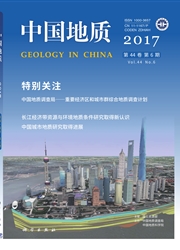

 中文摘要:
中文摘要:
横现河地区张岩沟双峰式火山岩位于勉略构造带三岔子一略阳段,由紧密共生的变质基性火山岩和变质中酸性火山岩组成.其原岩为亚碱性玄武岩和亚碱性流纹一英安岩。中酸性火山岩稀土元素含量明显低于玄武岩,表明中酸性火山岩为地壳部分熔融形成.而非分离结晶成因。玄武岩具有较高的zr含量与较高的Zr/Y值,表现出板内玄武岩特征.其具有的弧印记应为陆壳物质混染所致。LA—ICP—MS锆石u—Pb测试结果表明,流纹岩成岩年龄为(728±10)Ma(n=4,MSWD=0.14)。结合区域地质背景,认为张岩沟双峰式火山岩形成于地壳伸展机制下的大陆裂谷环境,预示着该地区新元古代洋盆的打开。这一新成果.对研究勉略带新元古代的构造演化以及探讨扬子地块北缘对Rodillia超大陆裂解的响应具有重要意义。
 英文摘要:
英文摘要:
Zhangyangou bimodal volcanic rocks are located in Hengxianhe area,Sanchazi-Lueyang segment of Mian-Lue tectonic zone. The bimodal volcanic rocks consist of metamorphosed basic volcanic rocks and metamorphosed acid-intermediate rocks in close association, and the protoliths are sub-alkaline basalt and sub- alkaline rhyolitic-dacite. On account of the higher REE concentrations in basalt than in rhyolitic-dacite, the authors hold that the origin of rhyolitic-dacite was partial melting of the crustal material rather than the fractional crystallization of the basaltic magma. Basic volcanic rocks show the intraplate geochemical characteristics such as high Zr concentrations and Zr/Y ratios, and their marks of arc result from the hybridism of the crustal material. The result of U-Pb isotope dating by means of Laser Ablation Inductively Coupled Plasma Mass Spectrometry makes it clear that the formation age of the rhyolite is (728±10) Ma (n=4, MSWD=0.14). Combined with the regional geological background, the authors consider that Zhangyangou bimodal volcanic rocks were formed in a continental rift environment under the crust extensional mechanism. The formation of Zhangyangou bimodal volcanic rocks heralded the opening of Neoproterozoic Ocean. This new achievement is of important significance both for the further study of the evolution of Mian-Lue tectonic zone and the breakup of Rodinia supercontinent and other continents on the north margin of the Yangtze block.
 同期刊论文项目
同期刊论文项目
 同项目期刊论文
同项目期刊论文
 Geochemical characteristics and zircon U-Pb isotopic ages of island-arc basic igneous complexes from
Geochemical characteristics and zircon U-Pb isotopic ages of island-arc basic igneous complexes from The LA-ICP-MS zircons U-Pb ages and geochemistry of the Baihua Basic igneous complexes in Tianshui a
The LA-ICP-MS zircons U-Pb ages and geochemistry of the Baihua Basic igneous complexes in Tianshui a Geochronology, geochemistry and tectonic setting of the Bairiqiete granodiorite intrusion (rock mass
Geochronology, geochemistry and tectonic setting of the Bairiqiete granodiorite intrusion (rock mass Regional Tectonic Transformation in East Kunlun Orogenic Belt in Early Paleozoic: Constraints from t
Regional Tectonic Transformation in East Kunlun Orogenic Belt in Early Paleozoic: Constraints from t LA-ICP-MS zircon U-Pb dating, geochemistry of the Mishuling intrusion in western Qinling and their t
LA-ICP-MS zircon U-Pb dating, geochemistry of the Mishuling intrusion in western Qinling and their t Mid-Neoproterozoic Tadong amphibolites at the junction of the East Kunlun and Western Qinling Orogen
Mid-Neoproterozoic Tadong amphibolites at the junction of the East Kunlun and Western Qinling Orogen Geochemistry and zircon U–Pb ages of granitic rocks in the Buqingshan tectonic mélange belt, norther
Geochemistry and zircon U–Pb ages of granitic rocks in the Buqingshan tectonic mélange belt, norther Geochemical Features, Age, and Tectonic Significance of the Kekekete Mafic-ultramafic Rocks, East Ku
Geochemical Features, Age, and Tectonic Significance of the Kekekete Mafic-ultramafic Rocks, East Ku 期刊信息
期刊信息
